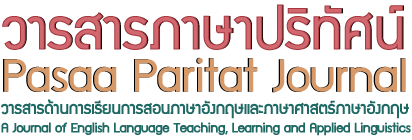การจัดการเรียนรู้โดยใช้โครงงานเป็นฐานร่วมกับคู่มือการเรียนรู้ เพื่อเสริมสร้างความเข้าใจ เรื่อง ประโยคเงื่อนไข ของนักเรียนชั้นมัธยมศึกษาตอนปลาย
DOI:
https://doi.org/10.58837/CHULA.PPJ.39.1คำสำคัญ:
การเรียนรู้โดยใช้โครงงานเป็นฐาน, ประโยคเงื่อนไข, คู่มือการเรียนรู้บทคัดย่อ
วิจัยครั้งนี้มีวัตถุประสงค์เพื่อ 1) เสริมสร้างความเข้าใจ เรื่อง ประโยคเงื่อนไข โดยใช้กระบวนการจัดการเรียนรู้โดยใช้โครงงานเป็นฐานร่วมกับคู่มือการเรียนรู้ของนักเรียนมัธยมศึกษาตอนปลาย 2) ศึกษาคะแนนพัฒนาการสัมพัทธ์ของแบบทดสอบก่อนและหลังเรียน 3) ประเมินความพึงพอใจต่อกระบวนการจัดการเรียนรู้โดยใช้โครงงานเป็นฐานร่วมกับคู่มือการเรียนรู้ของมัธยมศึกษาตอนปลาย วิจัยครั้งนี้ดำเนินการทดลองแบบกลุ่มทดลองหนึ่งกลุ่มวัดผลก่อน และหลังการทดลอง ต่อกลุ่มตัวอย่าง 1 กลุ่ม ที่เลือกแบบเจาะจง คือ นักเรียนชั้นมัธยมศึกษาศึกษาปีที่ 5 จำนวน 29 คน วิเคราะห์ข้อมูลโดยการหาค่าเฉลี่ย ค่าเบี่ยงเบนมาตรฐาน ทดสอบสมมุติฐานด้วย paired-sample T-test ผลการวิจัยพบว่า คะแนนเฉลี่ยหลังเรียนเพิ่มขึ้นอย่างมีนัยสำคัญทางสถิติ เมื่อเทียบกับคะแนนก่อนการเรียน ด้วยคะแนนเฉลี่ยหลังเรียน 8.17 เปรียบเทียบกับคะแนนก่อนเรียน 4.07 การศึกษาคะแนนพัฒนาการสัมพัทธ์ระหว่างแบบทดสอบก่อนเรียนและหลังเรียนพบว่า นักเรียนร้อยละ 48.28% มีคะแนนพัฒนาการสัมพัทธ์ในระดับสูงมาก ความพึงพอใจของนักเรียนต่อคู่มือการเรียนรู้พบว่า อยู่ในระดับพึงพอใจมาก โดยมีค่าเฉลี่ยที่ 3.85 นักเรียนร้อยละ 82.76% มีความพึงพอใจในระดับมาก ขณะที่นักเรียนร้อยละ 17.24% มีความพึงพอใจในระดับปานกลาง ผลจากการศึกษาครั้งนี้แสดงถึงความสำคัญต่อการประยุกต์ใช้การจัดการเรียนรู้โดยใช้โครงงานเป็นฐานร่วมกับคู่มือการเรียนรู้ ซึ่งสามารถส่งเสริมความเข้าใจ เรื่อง ประโยคเงื่อนไข ของนักเรียนชั้นมัธยมศึกษาตอนปลายได้
เอกสารอ้างอิง
Barell, J. F. (2006). Problem-Based Learning: An inquiry approach. SAGE Publications
Bender, W. N. (2012). Project-based learning: Differentiating instruction for the 21st century. Corwin Press.
Bilsborough, K. (2013). TBL and PBL: Two Learner-centred Approaches. https://www.teachingenglish.org.uk/article/tbl-pbl-two-learner-centred-approaches
Celce-Murcia, M. & Larsen-Freeman, D. (1999). The grammar book. Boston: Heinle & Heinle.
Chen, J., Guerra, A., Xiangyun, D., & Kolmos, A. (2022). Guest Project- or Problem-Based Learning (PBL) in Engineering Education: Variations and Prospects. International Journal of Engineering Education, 38(4). 876–878. https://www.ijee.ie/editorials/02_Guest_Editorial38-4.pdf
Chiou, B. (2019). The Application of Problem-based Learning Approach in English Grammar Instruction: A Pilot Study. Journal of Language Teaching and Research, 10(3). 446–453.
Coffin, P. (2013). The Impact of the Implementation of the PBL for EFL Interdisciplinary Study in a Local Thai Context. In K. Mohd-Yusof, M. Arsat, M. T. Borhan, E. de Graaff, A. Kolmos, & F. A. Phang (Eds.), PBL Across Cultures (pp. 191–197). Aalborg Universitetsforlag.
Cruickshank, D. R., Bainer, D. L., & Metcalf, K. E. (1999). Learning in action: A guide to developing effective project-based learning (2nd ed.). Corwin Press.
Darling-Hammond, L. (2008b). Conclusion: Creating schools that develop understanding. In L. Darling-Hammond, B. Barron, P. D. Pearson, A. H. Schoenfeld, E. K. Stage, T. D. Zimmerman, G. N. Cervetti, & J. L. Tilson (Eds.), Powerful learning: What we know about teaching for understanding (pp. 193–212). San Francisco, CA: Jossey-Bass.
Dirven, R. (1990). Pedagogical grammar. Language Teaching, 23(1), 1–18. https://doi.org/10.1017/S0261444800005498.
Fadhilawati, D. (2019). Improving the Students’ Grammar Achievement on Conditional Sentences by using memrise. Langlit An International Per-Reviewed Open Access Journal, 5(4), 83–95.
Fried Booth, D. L. (2002). Project work (2nd ed.). New York: Oxford.
Grant, M. M. (2002). Getting a grip on project-based learning: Theory, cases and recommendations. Meridian: A Middle School Computer Technologies Journal, 5(1).
Guthrie, C. (2010). Towards Greater Learner Control: Web Supported Project-Based Learning. Journal of Information Systems Education, 21, 121–130.
Harada, K., Kirio, Y., & Yamamoto, Y. (Eds.). (2008). Language Development in Foreign Language Learning through Project Based Learning [Project based learning for foreign language development]. (Japanese only). Kairyudo Publisher Co., Ltd., Tokyo Japan.
Kang, S-M. (2007). Why is it difficult to teach English subjunctive? Studies on English Language & Literature, 49, 21–35.
Kanjanawasee, S. (2014). Gain Scores. The Social Sciences Research Association of Thailand, 1(1). January–April: p. 1–20.
Khamkhien, A. (2011). Quantitative and qualitative views of Thai EFL learners’ learning oral communication skills. Academic Research International. 1(1). http://www.savap.org.pk/journals/ARInt./Vol.1(1)/2011(1.1-08).pdf
Kloppenborg, T. J., & Baucus, M. S. (2004). Project management in local nonprofit organizations: Engaging students in problem-based learning. Journal of Management Education, 28, 610–630. https://doi.org/10.1177/105256290426600
Knapp T. R. (2016). Why Is the One-Group Pretest-Posttest Design Still Used?. Clinical Nursing Research, 25(5), 467–472. https://doi.org/10.1177/1054773816666280
Krajcik, J. S., & Mamlok-Naaman, R. (2006). Using driving questions to motivate and sustain student interest in learning science. In K. Tobin (Ed.), Teaching and learning science: A handbook (pp. 317–327) Westport, CT: Praeger.d.
Krajcik, J. S., & Shin, N. (2014). Project-based learning. In R. K. Sawyer (Ed.), The Cambridge handbook of the learning sciences (2nd ed.) (pp. 275–297). New York, NY: Cambridge University Press.
Krauss, J., & Boss, S. (2013). Thinking through project-based learning: Guiding deeper inquiry. Corwin Press.
Murray, K., Bell, R., Frey, N., & Halverson, R. (2004). Learning by designing (Revised and expanded). Heinemann.
Nurcahyoko, K. (1). Project-based learning in teaching grammar for high and low motivated students The Case of The Tenth Graders of Sman 1 Bangsri In The Academic Year of 2013/2014. English Education Journal, 4(2). https://journal.unnes.ac.id/sju/index.php/eej/article/view/6671
Parker, W. C., Lo, J., Yeo, A. J., Valencia, S. W., Nguyen, D., Abbott, R. D., Nolen, S. B., Bransford, J. D., & Vye, N. J. (2013). Beyond breadth-speed-test: Toward deeper knowing and engagement in an advanced placement course. American Educational Research Journal, 50(6), 1424–1459. https://doi.org/10.3102/0002831213504237
Sattayatham A. & Honsa, S. (2007). Medical students’ most frequent errors at Mahidol University, Thailand. The Asian EFL Journal, 9(2), 170–194. https://asian-efl-journal.com/June_2007_EBook_editions.pdf#page=170
Simpson, J. (2011). Integrating Project-Based Learning in an English Tourism Classroom in a Thai University. [Doctoral Thesis, Australian Catholic University]. Sydney, Australia. https://doi.org/10.4226/66/5a961e4ec686b
Solomon, G. (2003). Project-based learning: A primer. Technology & Learning, 23(6), 20–27.
Somjai, S., & Soontornwipast, K. (2020). The integration of implicit and explicit vocabulary instruction, project-based learning, multimedia, and experiential learning to improve Thai EFL senior high school students’ vocabulary ability. Arab World English Journal (AWEJ) Special Issue on CALL, (6). 171–190. https://dx.doi.org/10.24093/awej/call6.12
Soparat, S., Arnold, S.R., & Klaysom, S. (2015). The Development of Thai Learners' Key Competencies by Project-Based Learning Using ICT. International Journal of Research in Education and Science (IJRES), 1(1), 11–22.
Srikrai, P. (2008). Project-based learning in an EFL classroom. Journal of Humanities and Social Sciences, Khon Kean University, 25, 85–111.
Supadol, P., Sukreeyapong, W., Intarakumhaeng, P., Siripan, K., Chantanapim, W., & Nesusin, N. (2014). Results of Learning Activities of Grade 1 Thai Language Subjects Using the Project-based Approach. Procedia - Social and Behavioral Sciences, 116, 1444–1448. http://dx.doi.org/10.1016/j.sbspro.2014.01.413
ดาวน์โหลด
เผยแพร่แล้ว
รูปแบบการอ้างอิง
ฉบับ
ประเภทบทความ
สัญญาอนุญาต
ลิขสิทธิ์ (c) 2024 วารสารภาษาปริทัศน์

อนุญาตภายใต้เงื่อนไข Creative Commons Attribution-NonCommercial-NoDerivatives 4.0 International License.



